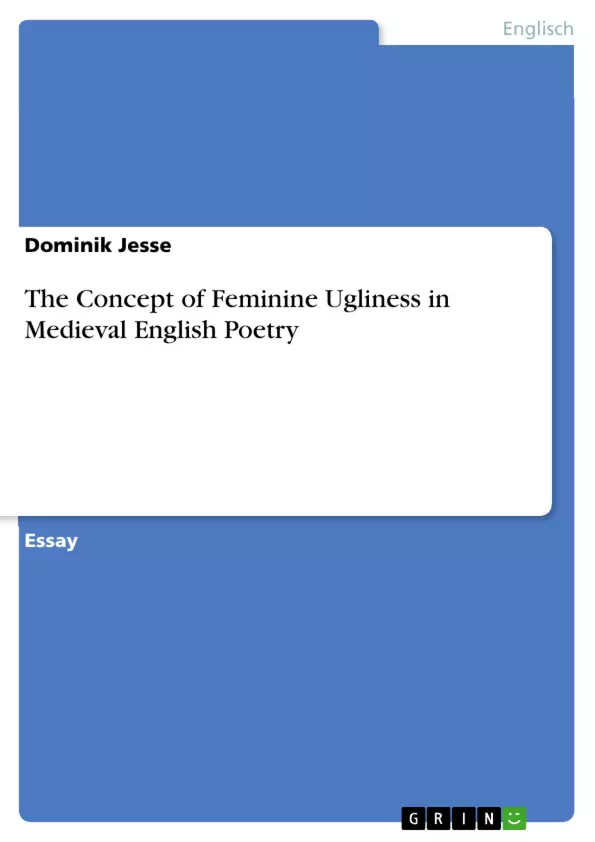This essay does not focus solely on how medieval poets used the presentation of ugliness in their art, but pays attention as well to the function which the portrayal of female ugliness fullfilled in their respective work. This aspect makes the essay eminently worthwhile.
Diese Arbeit berücksichtigt nicht nur auf welche Weise "Hässlichkeit" von den mittelalterlichen englischen Poeten verwendet wurde, sondern auch, welche Funktion die Beschreibung von Hässlichkeit innerhalb der entsprechenden Dichtungen erfüllte. Daduch wird dieses Essay besonders wertvoll.
Inhaltsverzeichnis
- Introduction - black and white
- Ugliness - definition through contrast
- Ugliness beauty of variety
- Ugliness spouse of immorality
- Conclusion-grey
Zielsetzung und Themenschwerpunkte
Diese Arbeit untersucht die Darstellung weiblicher Hässlichkeit in der mittelalterlichen englischen Lyrik. Ziel ist es, die Funktionen und Gründe für die Verwendung von Hässlichkeitsbeschreibungen aufzuzeigen und deren Zusammenhang mit dem vorherrschenden Schönheitsideal zu beleuchten. Die Arbeit trägt zur noch jungen Forschung auf diesem Gebiet bei.
- Definition von Hässlichkeit im Kontrast zu Schönheit
- Hässlichkeit als Ausdruck von Vielfalt und Abweichung von Normen
- Der Zusammenhang zwischen Hässlichkeit und Unmoral im Kontext der Physiognomie
- Die Funktion von Hässlichkeitsbeschreibungen in der mittelalterlichen Lyrik
- Analyse spezifischer Beispiele aus der mittelalterlichen englischen Lyrik
Zusammenfassung der Kapitel
Introduction - black and white: Die Einleitung stellt die Forschungsfrage nach den Gründen für die Darstellung weiblicher Hässlichkeit in der mittelalterlichen englischen Lyrik. Sie verweist auf das etablierte Schönheitsideal und dessen konventionelle Darstellung in der Literatur. Die Arbeit zielt darauf ab, die Funktionen von Hässlichkeitsbeschreibungen als bewusstes Stilmittel zu untersuchen, das im Kontrast zur Schönheit steht und auf den unmoralischen Charakter der beschriebenen Frau hinweist. Der Fokus liegt auf der Analyse des Zusammenhangs zwischen physischer Erscheinung und Moral im Kontext der Physiognomie.
Ugliness - definition through contrast: Dieses Kapitel definiert den Begriff der Hässlichkeit im Kontext des mittelalterlichen Schönheitsideals. Da es kein Ideal der Hässlichkeit gab, wird diese im Kontrast zur damals vorherrschenden Vorstellung von Schönheit definiert. Das Kapitel beschreibt das strenge und konventionelle Schönheitsschema, das auf antiken Vorbildern und der höfischen Lyrik beruhte. Hässlichkeit wird als Transgression dieses Schemas durch Unordnung, Gegenidealierung und unpassende Vergleiche dargestellt. Der Fokus liegt auf der strengen Ordnung und Idealierung der Schönheitsbeschreibungen, die als Gegenpol zur Hässlichkeit fungiert.
Ugliness beauty of variety: Dieses Kapitel analysiert, wie die Überschreitung des Schönheitsideals in den Bereich der Hässlichkeit gelang. Es wird gezeigt, dass mittelalterliche Dichter durch Unordnung in der Beschreibung, Gegenidealierung und unpassende Vergleiche die gängigen Konventionen parodiert haben. Konkrete Beispiele aus der Lyrik werden vorgestellt, die die Umkehrung positiver Attribute und den Einsatz ungewöhnlicher Vergleiche zur Darstellung von Hässlichkeit illustrieren. Die Vielfalt der Hässlichkeitsdarstellungen wird betont, die sich von den strengen Regeln der Schönheitsideale abhebt.
Ugliness spouse of immorality: In diesem Kapitel wird der Zusammenhang zwischen Hässlichkeit und Unmoral im Kontext der Physiognomie hergestellt. Die Physiognomie, die Lehre von der Deutung des Charakters aus dem Aussehen, verband körperliche Eigenschaften mit der Moral. Hässlichkeit diente somit als Indikator für Unmoral und wurde als bewusstes Stilmittel eingesetzt, um den schlechten Charakter einer Frau hervorzuheben. Die Hässlichkeitsbeschreibung wird als rhetorisches Mittel verstanden, das eine moralische Bewertung beinhaltet.
Schlüsselwörter
Mittelalterliche englische Lyrik, Weibliche Hässlichkeit, Schönheitsideal, Physiognomie, Unmoral, Kontrast, Gegenidealierung, Unordnung, Inappropriate comparisons, Stilmittel.
Häufig gestellte Fragen (FAQ) zur mittelalterlichen englischen Lyrik und weiblicher Hässlichkeit
Was ist der Gegenstand dieser Arbeit?
Diese Arbeit untersucht die Darstellung weiblicher Hässlichkeit in der mittelalterlichen englischen Lyrik. Sie analysiert die Funktionen und Gründe für die Verwendung von Hässlichkeitsbeschreibungen und deren Zusammenhang mit dem vorherrschenden Schönheitsideal.
Welche Themen werden behandelt?
Die Arbeit behandelt folgende zentrale Themen: die Definition von Hässlichkeit im Kontrast zu Schönheit; Hässlichkeit als Ausdruck von Vielfalt und Abweichung von Normen; den Zusammenhang zwischen Hässlichkeit und Unmoral im Kontext der Physiognomie; die Funktion von Hässlichkeitsbeschreibungen in der mittelalterlichen Lyrik; und die Analyse spezifischer Beispiele aus der mittelalterlichen englischen Lyrik.
Wie wird Hässlichkeit definiert?
Da es im Mittelalter kein explizites Ideal der Hässlichkeit gab, wird diese im Kontrast zum vorherrschenden Schönheitsideal definiert. Hässlichkeit wird als Transgression dieses Schemas durch Unordnung, Gegenidealierung und unpassende Vergleiche dargestellt. Die strenge Ordnung und Idealierung der Schönheitsbeschreibungen bilden den Gegenpol.
Welche Rolle spielt die Physiognomie?
Die Physiognomie, die Lehre von der Deutung des Charakters aus dem Aussehen, spielt eine wichtige Rolle. Hässlichkeit diente als Indikator für Unmoral und wurde als bewusstes Stilmittel eingesetzt, um den schlechten Charakter einer Frau hervorzuheben. Die Hässlichkeitsbeschreibung wird als rhetorisches Mittel mit moralischer Bewertung verstanden.
Wie wird Hässlichkeit in der Lyrik dargestellt?
Mittelalterliche Dichter parodieren gängige Konventionen durch Unordnung in der Beschreibung, Gegenidealierung und unpassende Vergleiche. Konkrete Beispiele aus der Lyrik illustrieren die Umkehrung positiver Attribute und den Einsatz ungewöhnlicher Vergleiche zur Darstellung von Hässlichkeit. Die Vielfalt der Darstellungen hebt sich von den strengen Regeln der Schönheitsideale ab.
Welche Kapitel umfasst die Arbeit?
Die Arbeit gliedert sich in eine Einleitung ("Introduction - black and white"), drei Hauptkapitel ("Ugliness - definition through contrast", "Ugliness beauty of variety", "Ugliness spouse of immorality") und eine Schlussfolgerung ("Conclusion-grey"). Jedes Kapitel untersucht einen Aspekt der Darstellung weiblicher Hässlichkeit.
Welche Schlüsselwörter sind relevant?
Relevante Schlüsselwörter sind: Mittelalterliche englische Lyrik, Weibliche Hässlichkeit, Schönheitsideal, Physiognomie, Unmoral, Kontrast, Gegenidealierung, Unordnung, Inappropriate comparisons, Stilmittel.
Welches Ziel verfolgt die Arbeit?
Das Ziel der Arbeit ist es, die Funktionen und Gründe für die Verwendung von Hässlichkeitsbeschreibungen in der mittelalterlichen englischen Lyrik aufzuzeigen und deren Zusammenhang mit dem vorherrschenden Schönheitsideal zu beleuchten. Die Arbeit trägt zur noch jungen Forschung auf diesem Gebiet bei.
- Quote paper
- Dominik Jesse (Author), 2015, The Concept of Feminine Ugliness in Medieval English Poetry, Munich, GRIN Verlag, https://www.grin.com/document/305985



